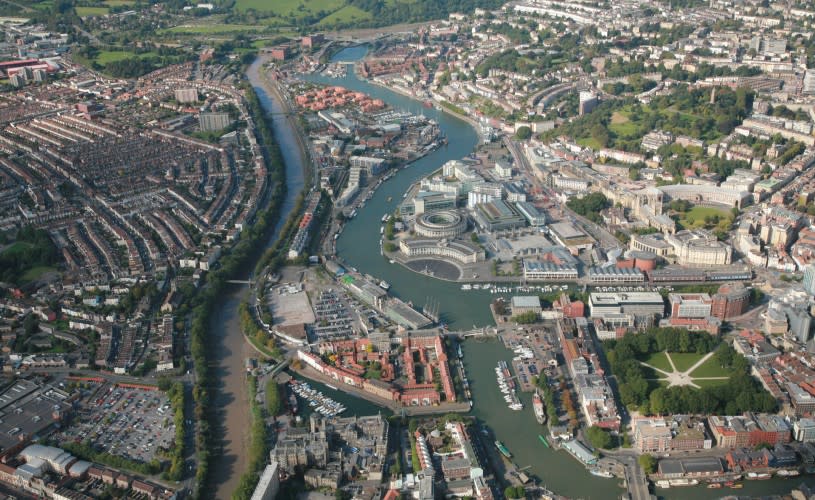The red brick buildings and chimney of Underfall Yard are an iconic sight on Bristol’s Harbourside. But how did this working boatyard and visitor attraction, now considered the heart of the harbour, come to be?
Discover its fascinating story in this guest article from the Underfall Yard team, featuring magnificent feats of engineering, Brunel, boatbuilding and more.

Image: The Underfall Yard
The creation of the harbour
Bristol’s Floating Harbour was engineered by William Jessop in the early 19th Century to manage issues the city had with the tide. The high tidal range of the Bristol Channel – the second highest in the world – affected trade and shipping, as ships would bottom out on the mud during low tide and could get stranded.
Enter Jessop, a civil engineer who proposed changing the course of the River Avon, which flowed through the harbour and much of the Underfall Yard area. His plans diverted the flow of water into a man-made river, the New Cut. Completed in 1809, this allowed ships to sail swiftly to Bristol and float in the harbour, whatever the tide.

Image: Aerial view of the Harbourside and The New Cut
From Overfall Dam to Underfall Yard
Jessop’s design included the Overfall Dam, which allowed excess water to flow over it and into the New Cut.
There was an issue here. The water that comes into the Floating Harbour from the River Avon carries a lot of mud, known as silt. The low flow rate through the harbour means the water is not able to carry the silt. Large build-ups on the harbour floor made it difficult for ships to navigate through. The silt had to be dug out by hand every six months, which disrupted shipping and trade.
Isambard Kingdom Brunel, the engineer behind Clifton Suspension Bridge and the SS Great Britain, was consulted about how to solve this problem in the 1830s. He proposed adjustments to Jessop’s original design as well as the use of dredgers.
Later in the 19th century, engineers, including Joseph Green and John Ward Girdlestone, further improved the system by creating underground tunnels linking the harbour and the New Cut. One of the tunnels is much deeper than the others, so it could use the pressure of the water in the harbour to clear the silt, a system still in use today.
And so ‘underfalls’ replaced the Overfall Dam, hence the name Underfall Yard.
Maintaining Bristol’s docks
Many of Underfall Yard’s buildings date from the 1880s, when it became a hub for engineering activities in the docks, headed up by Docks Engineer John Ward Girdlestone. There were workshops for plumbers, pattern makers, blacksmiths, divers, engineers, fitters and shipwrights. At its peak, a workforce of 400 people delivered the year-round maintenance programme.
The Machinery Workshop is one of the last remaining buildings at Underfall Yard used for its original purpose by Bristol City Council, who now manage the docks. It contains machine tools designed to shave metal into the desired shapes, such as a planer, lathes and a shaping machine.
The belt-driven machinery is no longer used for operational purposes but is being restored and brought back into action by Underfall Yard Trust and its team of dedicated volunteers.
There are also three fully equipped blacksmithing forges located within the workshops with over 350 tools. This demonstrates the wide range of work the blacksmiths carried out in the city docks.
.jpg)

Image - In the workshop at Underfall Yard
Boatbuilding at Underfall Yard
Today, Underfall Yard Trust is still a working boatyard. It hosts maritime businesses such as boatbuilders, riggers, blacksmiths, welders and more. The boatbuilding and maintenance services offered here keep traditional skills alive and provide essential support to the vibrant boating community of Bristol Harbour.
There’s been a slipway to get ships out of the water and into the yard for maintenance since the 1850s. The current one dates back to 1890, although the original hydraulic winding gear was replaced by an electric motor in 1924.
The slipway was restored in the 1990s and is still in use today. Vessels can book through the Underfall Yard Trust to come out for minor repairs or major works. Some very well-known Bristol vessels use the slipway for maintenance, such as The Matthew and boats belonging to Bristol Ferry Boats.
Visiting Underfall Yard today
While the workshops hired by private businesses are closed to the public, Underfall Yard welcomes visitors to explore the rest of the site.
The visitor centre is based in the former Hydraulic Power House, which once powered many harbour installations such as lock gates, swing bridges and cranes. Here you can discover hands-on displays and a giant interactive map to learn more about the yard, past and present. A team of volunteers also runs demonstrations in the Pump Room, sharing their amazing knowledge about all things Underfall Yard too. Once you're done exploring the exhibits and boatyard, enjoy some refreshments and take in the view from the Underfall Cafe.

Image - Underfall Cafe
Brush up on more Bristol history:





